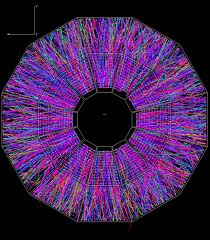Quark-Gluon Plasma
Systems consisting of deconfined quarks and gluons, the fundamental constituents of matter and the mediators of the strong force, are produced in controlled laboratory conditions in reactions of heavy nuclei at ultra-relativistic energies. These so-called “quark-gluon plasmas” (QGPs) exist at very high temperatures and energy densities similar to those found a few microseconds after the Big Bang. The quest to discover and characterize the properties of this new state of matter via ultra-relativistic collisions of large nuclei is an active research thrust at many experimental facilities, such as the Bevalac, the CERN Super Proton Synchrotron (SPS), the Relativistic Heavy Ion Collider (RHIC) and the Large Hadron Collider (LHC).

Thousands of tracks are recorded when the QGP (created in a central Au+Au collision at RHIC) cools down and transforms into ordinary elementary particles, which reach the detectors.
Contrary to early expectations, data collected have revealed that the constituents of the QGP created in very high-energy nucleus-nucleus collisions appear to be strongly coupled, similar to the strongly coupled electron-ion plasma (SCP) state. Specifically, ”elliptic flow”—an almond-shape expansion characteristic of asymmetric collisions—is consistent with hydrodynamic simulations with zero or very small viscosity \(\eta\). This suggests that the mean free paths of the quarks and gluons in the QGP are very small and the system is strongly coupled. Another important piece of evidence is the strong suppression in the rate of energetic particle and jet production rates. These energetic particles and jets (collimated showers of particles) carry momenta hundreds of times larger than the temperature of the plasma. Nevertheless, they couple strongly to the medium and lose energy via collisional and radiative processes.
The differences between the QGP and the strongly coupled Coulomb plasmas notwithstanding, the scientific community has rapidly recognized the potential of strongly coupled plasma physics to help understand the fundamental properties of the QGP, but until today, the similarity has largely been unexploited. Despite the fact that the latter interacts electro-magnetically and the former interacts through the strong nuclear force, there is tremendous commonality in the intellectual approach to the theoretical and experimental tools for their characterization.



